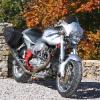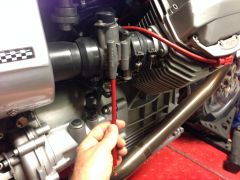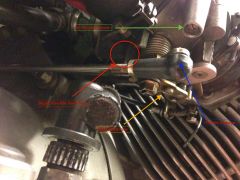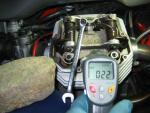-
Posts
19,420 -
Joined
-
Last visited
-
Days Won
1,085
Content Type
Profiles
Forums
Events
Gallery
Community Map
Everything posted by docc
-
Excellent! Thank you! I'll be trying to get that dedicated Diagnostic Cable thread posted and pinned soon so we can, collectively, post reliable cabling sources worldwide.
-
Perhaps there is some good information in my three year thread referencing my Sport's Rear Drive leak. I will say that I, my-own-self, scratched the inner seal surface prying out the large seal which didn't help matters any. I was eventually saved from the Leaky Abyss by Andy York, The Seal Whisperer. http://www.v11lemans.com/forums/index.php?showtopic=15908&p=186069
-
Pete Roper has reminded us that there are several sources of oil leaks at the rear of the engine. Worth reading his comments (as always): http://www.v11lemans.com/forums/index.php?showtopic=3751&p=35372
-
Haha, right? The there is a curious mix of factors that have created the situation that there are no pictures of SSR One. That was the first year of my transition to digital photography and lost two years of pictures in a classic PC crash. Bill has a shoebox of Kodak prints somewhere in his analog archive he is promising to ferret out. Then there is the whole plausible deniability thing . . .
-
There are a whole series of things that will likely help the pop/stumble: Start with a complete "Decent Tune Up" Make sure all of your electrical connections and grounds are both clean and tight. Inspect the spark plug leads as they leave the coils. What type of Engine Temperature Sensor holder is fitted? On the weave, it's true the early Sports are more prone, but the '02-'04 rake is not different - it is the frame that is longer and the subframes are braced. Start here by "setting your sags." (A process of making sure your springs are right for your weight and the preloads are correct.) This cures so many suspension ills. Very likely your rear is too soft and/or sagging too much. You can try to increase preload and, perhaps, rear tire pressure. Many have also dropped the front triple clamps on the forks a bit (mine are down ~5mm).
-
Revised Post #1, but cannot find the Caspers breakout harness now. Anyone?
-
nuevototem, thanks for the excellent questions! These will help make this thread more usable for all of us. 1) Yes, leave the right side idle stop screw defeated, backed all the way out. It is the simplest to set the idle from the left side. The left idle stop screw will maintain both throttle bodies through the linkage rod. Some have reported such wear that turning the Right Idle Stop Screw in to index the right throttle body at idle gives them more stable idle. Do this as necessary. "Fine tuning?" 2) Short answer? The V11 may "breathe better" at idle. The V11 Workshop Manual does state 1/2 turn. "Micha's Method" also uses one full turn, as well as the 1100 Sporti? I've tried using the 1/2 turn repeatedly over my twenty-or-so tunes (plus other V11 I've tuned), and have found the idle more stable at one full turn, especially in high ambient temperatures. It may be helpful to use the "air screws" to balance the Throttle Bodies at idle, once the Balance Knob is used to balance the Throttle Bodies at *some* rpm. If the Air Screws are more than 1/4 turn different to balance at idle, there is some other problem. (More fine tuning). 3) The right side Throttle Body influences the TPS (Throttle Position Sensor) directly. Its baseline position establishes the ECU's index to the "map." Best results *may be* obtained using the right side to index the TPS (to the ECU) while the left side is used to set the synchronization and the desired idle speed. Notice that the entire linkage is tensioned from the left by the throttle cable. 4) I referenced danl's thread on his influence developing the TPS Breakout Harness with Casper's. What a fantastic contribution! Thanks for reporting the broken links. I'll have to work those out. I am intending to pin a dedicated Technical Topics thread on the Diagnostic Cables. There are three necessary diagnostic cables and we must be able to source them worldwide over a span of time. (EDIT: I replaced the Caspers link in Post #1 to go directly to the product. Thanks, nuevototem for the link!) Thank you, again! I would like to use this time and everyone's contributions to clarify a simple, basic tune-up procedure, then pin it. Then, there will *always* be "Fine Tuning"
-
Still not a single pic of the inaugural 2004 SSR?
-
Would that they would just give the world a fresh military/fleet service motorcycle and take on Giulio Carcano's 3-cylinder diesel idea. I know it's not racing, but seems so much more plausible.
-
Wow, Scott, that is gorgeous. I love those falls. I think, now, the Spine Raid is a thing of its own, with or without me: South'n Spine Raid The weekend after Labor Day/ Tellico Plains, Tennessee ("Show Up, Plan Your Own Route")
-
Understood regarding silicone versus silicon, yet if a high intensity electrical arc is passed through silicone grease, can the elemental silicon be oxidized into the glass-like compound silicon dioxide? I dunno, but there are sources that say "uh-oh" especially in proximity to relays and switches. Sounds like Vaseline is safe. For all sorts of fun and interesting applications . . .
-
-
-
From the album: docc's sport
-
From the album: docc's sport
Throttle Body air bypass screw -
Yeah, I was always told "stone cold", but I did some careful measurements using guzzidiag to monitor engine temperature and checked the valve lash over a period of time. I was surprised that the motor cooled 90% and the lash returned to the "stone cold" spec after just 40 minutes. A Very Experienced and well respected Guzzi owner/tech told me the same at this recent Spine Raid. More detailed post here: http://www.v11lemans.com/forums/index.php?showtopic=19137&p=205658 The great thing about this discovery is that it removes the hassle of having to wait overnight to do this procedure. The six steps above can be performed in a couple hours tops.
-
My recollection is that silicone will gradually form a silicon dioxide ("glass") layer on any switch or relay contacts from the effects of the brief arc that occurs as the contacts make or break. Glass, of course, is a tremendous insulator. Also (again, my recollection from a knowledgeable person), that Ford Motor Company discovered infiltration of wiring for a considerable distance leading to concerns of the formation of silicon dioxide and degradation of electrical conductivity. Being a poor scientist myself, these are just recollections of statements I found compelling.
-
Ten Spine Frames: Blueboarhound Daytona Josh Sport 1100 docc 2000 V11 Sport, silver brlawson 2000 V11 Sport, black nobleswood 2003 Sport Naked, red scott2525 Ballabio footgoose 2002 LeMans, red/grey JRD 2002 LeMans, champagne Nick Coppa Italia Jake Rosso Corsa, (rosso, of corsa!) Other Guzzis: 1200 Sport The Tennessee Tuxedo Stelvio NTX danl Stelvio über alles Wayne Orwig Hotdog&mustard EV Bill Hagan Honorable sportbike twins: BMW RS, red Gary 'zuki SV1000, silver Bill from Indiana carbonfiberducatirocketship Tim the Enchanter Oh, wait, not the "breakdown" of the attendance? The Tennessee Tuxedo had a weak valve cover gasket that got exponentially worse after attempting to tighten it. No other mechanical issues, only "Tech."
-
Beautiful photo of a beautiful LeMans! I had planned on getting to those falls this year, but alas - I'm glad you guys did!!
-
A recurring theme with running issues of the V11 Moto Guzzi is that a decent tune-up often effects an amazing improvement. It is The First Place to start. This past weekend, we collectively tuned two V11 in the garage of the South'n Spine Raid. Both bikes sounded fabulous after and the members have given good reports on the results. While the *suggested* procedure is fresh in my mind, I figured to get the basics down. There are several ways to achieve a tune-up on a V11, some more time effective and some more elaborate. This one strikes a balance that is approachable by most owners with a little effort and a few tools. ___________________________________________________________________________________________________________________ 1) Valves/ Plugs: When cool (after the bike is off ~45 minutes), remove the plugs, adjust the valves to 0.006"/0.008" (.15mm/.20mm), then gap and install fresh plugs. 2) TPS Baseline: Using a Casper's TPS Breakout Harness (or equivalent), disconnect the right throttle linkage, release the upward facing slotted screw for the high idle cam, back out the difficult to reach 2.5mm hex-drive right-side idle stop set-screw, and clean the throttle butterfly, throttle return spring, and the underside of the throttle bodies (if necessary). It is critically important that the throttle plate is COMPLETELY closed and all of the above have been seen to! Many say to even "snap" the throttle closed a few times (within reason) to seat the plate fully closed. Others "zip-tie" the throttle plate firmly closed. Otherwise, you can simply apply a firm, constant pressure with one hand to ensure the plate is COMPLETELY closed. This indexes the throttle opening to the entire fuel-ignition mapping and cannot be over-emphasized. Loosen the TPS fasteners only enough to tap it or budge it slightly, it is VERY sensitive. Changing the TPS fasteners to standard hex drives (from the factory Torx) simplifies the process (M4-0.7 thread pitch x 17mm long). With a quality voltmeter, connect the positive to the violet/black wire and the negative to the violet (the yellow is not used for this setting). With the Run Switch on, switch on the keyed Ignition Switch. Adjust the TPS to 157 milivolts (most accurate over the factory value of 150 mv). Realize the TPS value changes when it is tightened down, so just repeat until you're in range. Reconnect the throttle linkage and set the high idle cam so it just nudges the throttle when engaged [we will recheck this after the last step, "6) Idle Speed"]. Leave the right-side idle stop backed out. (Some have found using both idle stop screws gives a more stable idle.) (EDIT/May 2019): Having had two TPS go bad after 50,000-62,000 miles/ 79.000-100.000 km, it is simple enough to check the TPS for faults when it is hooked up to the DOM (Digital-Ohm-Meter) . Switch the DVOM to resistance in the 2000 Ohm range with the key off. Slowly and smoothly open and close the throttle body and observe for a smooth transition of increasing and decreasing resistance from the potentiometer (TPS). If there are jumps and glitches or drops and variations in the resistance, the TPS should be replaced. Be certain to set the DVOM back to > DC voltage < before baselining the TPS in millivolts or you'll think something is terribly wrong! 3) CO Fuel Trim: Using guzzidiag software interface (or equivalent), connect your computer to the V11 with the two necessary diagnostic cables. Available from several sources, be certain the OBD cable is properly FTDI chipped. >> Check the Fuel Trim/ CO. If it is deep in the negative double digits, adjust it to zero. That may not be the exact AFR, but it will be immensely better than negative double digits or more (values of -27 to -128 have been reported!). Adjusting the Fuel Trim/CO with Guzzidiag requires the motor to be at operating temperature; simply follow the prompts on Guzzidiag. (The CO Fuel Trim can also be set with TunerPro at any temperature, but that's beyond this basic procedure). >> Don't worry about any other shown values at this point. >> Lambda (oxygen sensor) equipped V11 must have the Lambda sensors turned off in TunerPro. 4) Air Bypass Screws: Turn the upward facing Throttle Body air bypass screws in all the way and back them out one full turn. It is quite common that the tips of these become very sooty along with the passageways. If you have the time and inclination, remove them and clean them and the passageways with some throttle body cleaner. Watch your eyes, Eugene! (There is only a captured O-ring on them and no spring or tiny ball waiting to exit the universe!) [edit/May 2023: These O-rings should be inspected due to their age. Deformed, torn, or damaged O-rings should be replaced.] 5) Throttle Body Balance: Bring the engine to operating temperature. Connect a suitable Throttle Body balance tool like "TwinMax," manometer, alcohol/Hg sticks or the equivalent to the vacuum taps at the junction of the heads. With the white Nylon knob on the left, balance the vacuum at two or three thousand RPM or so (not idle). Make certain the white knob does not interfere with the shock's reservoir or anything else. See that the throttle linkage rod does not foul the speedometer drive on the right side. If you open and close the bell crank of the left throttle body, be certain the cable seats itself back in the groove. [Consider a lock nut against the white knob per Dave Richardson/Guzziology.] Some like to fine tune the idle balance using the air bypass screws, one in a little, one out a little to show good balance at idle. 6) Idle Speed: Let it idle and adjust the 2.5mm hex-drive left-side idle stop set-screw (easy to get to) to put the idle where you and your V11 are happy. Technically 1050+/- 50, I find mine *happier* a little higher (around 1150-1200+). Don't worry over the *degrees of opening* or the TPS idle voltage; seriously, just put the idle where the motor idles nicely for your conditions and liking. Once Steps 1-5 are set, you can put the idle anywhere you want. But you cannot start here. [Be certain the throttle cable has the appropriate freeplay to not pull on the throttle linkage in the idle position. Finally, recheck that the fast idle cam is not making contact, but just nudges the right throttle linkage when engaged.] ___________________________________________________________________________________________________________________ That's a "decent tune-up." I prefer to tune *early & often* finding that even at 5,000 miles (8.000 km), the V11 runs sweeter after setting the valves, fresh plugs, and a throttle body balance. There is a lot that could be added here, and many well informed owners and technicians do things differently, yet this fairly concise procedure has been shown to give very satisfying results with reasonable effort. As always YMMV, for informational purposes only, and no small furry animals were harmed in the testing procedures.
- 189 replies
-
- 15
-

-

-
I had hoped to check a few V11 at the South'n Spine Raid (there were eight!), but it proved more cumbersome than I thought. (*Other* TechSessions prevailed! ) I did hit mine with the IR reader and found the 2nd/Headlight Relay and 4th/ECU Relay about 125ºF and the 5th/FI Relay ~147ºF. That difference would be quite discernible to the fingers, let alone the lips ) Seems the 1st/Starter Relay and 3rd/Neutral Relay were ~115ºF. ("as I recall . . ."). I did not compare that to the surrounding materials. I didn't have time to take notes, so may try to get another reading when things aren't as pressing. EDIT: Notably, my headlight circuit is separated from these relays (#1 and #2).
-
Ten Spine Frames , four other Guzzi, and two V-twin sportbikes from nine States. What a grand time! Best, yet! Excellent, wonderful, fabulous folks! . . . and, of course, no shortage of TechSessions . . .
-
Wow - those are both great companies with excellent products. Any pics of those mounted to a V11?





